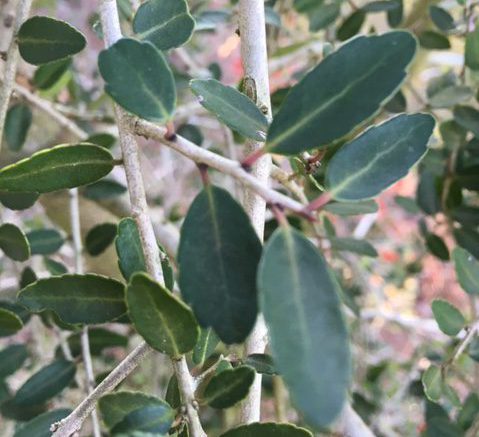
by Julie McConnell | Jun 3, 2021
If you are looking for an interesting native plant that attracts wildlife and makes a statement, look no further than Weeping Yaupon Holly Ilex vomitoria ‘Pendula’. The weeping growth habit with olive green leaves and white bark are attractive year-round. A bonus are the showy bright red berries that attract birds in the fall and winter. It is a cultivar of Yaupon Holly Ilex vomitoria which is tolerant of variable light and soil conditions making it a very adaptable plant.
Weeping Yaupon is a small evergreen tree that grows 15-30 feet tall with a mature width of 6-12 feet. Once established it has a high tolerance to drought conditions and is also able to sustain salt spray making it a good fit for coastal landscapes.
For more information visit https://edis.ifas.ufl.edu/publication/ST312

by Pat Williams | May 27, 2021
Our Gardening in the Panhandle blogs cover many horticultural topics concerning yards, however let us not forget about properties that contain a body of water (pond, lake, retention or detention basin, stream, river or Gulf of Mexico). Out of the nine Florida-Friendly Landscaping™ principles, five directly deal with water quality. Those principles are #2 Water Efficiently, #3 Fertilize Appropriately, #6 Manage Yard Pests Responsibly, #8 Prevent Stormwater Runoff, and #9 Protect the Waterfront. An easy argument can be made that the remaining four principles (#1 Right Plant, Right Place, #4 Mulch, #5 Attract Wildlife, and #7 Recycle) can also impact water quality on your properties.
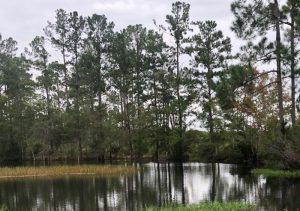
Photo Credit: University of Florida/IFAS Extension
The quickest and easiest way to start improving water quality is setting up a maintenance-free zone along your shore. At minimum, you should keep all chemicals 10′ away from the water’s edge and increase that distance as your slope becomes steeper. Chemicals include all fertilizers (#3) and any pesticides/herbicides (#6) meant for the landscape (there are times when situations arise where treatment of the water is warranted). If you must fertilize up slope, make sure to reduce irrigation (#2) to about 25% of normal the first time which keeps the fertilizer from dissolving and running down your slope’s surface (#9).
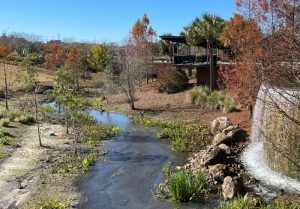
Cascades Park in Tallahassee, FL.
If possible replace turfgrass with a no mow zone containing plants adapted for shorelines to prevent applications of fertilizer and chemicals. Plants (#1) other than turfgrass will have deeper roots, stabilize the bank better and absorb more chemicals before entering the water. These taller plants in turn can become habitats (#5) for birds and other specimens which can increase your ecosystem’s biodiversity. Some properties have collection swales or low lying areas where water pools and then flows into the water. It is best to understand how water flows through the property and reduce chemicals in those areas too (#8).

Heavy rains caused water levels to raise around this pond and decomposing leaf litter added a film over the pond.
As gardeners, we tend to compost our leaves and yard debris (#7) plus use mulch (#4) to reduce water loss from our soils. Keep mulches and compost piles away from flood zones and when possible keep leaves from washing into your water as they can create films on the surface. Never allow grass clippings to land on water surfaces as they will add nutrients when tissue decays.
As Florida continues to grow, we all must play an important role in keeping our water clean and safe for us, animals, birds, and aquatic life. If you have questions on improving your water quality, please contact your local county Extension Agent or Water Regional Specialized Agent (RSA). For additional information visit these other sites.
Protecting Florida’s Water Resources: https://gardeningsolutions.ifas.ufl.edu/care/florida-friendly-landscapes/floridas-water-resources.html
Living on Water’s Edge: http://www.sarasota.wateratlas.usf.edu/upload/documents/LivingontheWatersEdgeFreshwater.pdf
Urban Fertilizer Ordinances in the Context of Environmental Horticulture and Water Quality Extension Programs: Frequently Asked Questions: https://edis.ifas.ufl.edu/publication/AE534

by Sheila Dunning | May 6, 2021
Some very exciting things have come from all the computer time that COVID-19 forced upon the University of Florida technology specialists – new updated websites. If you haven’t searched for UF publications or Florida-Friendly Landscaping advice in a while, you will be pleasantly surprised at what is available.
 UF/IFAS has had a long history of providing electronic access to publications, beginning in the early 1990s when it began producing handbooks of documents on CD-ROMS. By the mid-90s the Florida Agricultural Information Retrieval System (FAIRS) website went online. In 1998, the name was changed to Extension Data Information Source (EDIS) to reflect changes in its scope and function. EDIS became the single source for all Extension publications and was also adapted to permit Extension units to print documents on an as-needed basis. More recently in 2006, the UF/IFAS Solutions for Your Life web initiative has brought EDIS publications together with other valuable web resources. Now, after 25 years as a valuable online resource from UF/IFAS, the EDIS website has been rebranded as Ask IFAS. The new site is modern, mobile-friendly and will make Extension publications even easier to find. There are many new features including videos and two Ask IFAS specific indexes: Experts and Topics. The new indexes enable users to find contact information for specific agents and specialists by their name or department. Information by individual topics is easier to search also. Ask IFAS carries on EDIS’ role as a comprehensive, single-source repository of all current UF/IFAS numbered peer-reviewed publications. Each year, visitors to the EDIS website access one of over 6,500 publication titles more than 17.5 million times.
UF/IFAS has had a long history of providing electronic access to publications, beginning in the early 1990s when it began producing handbooks of documents on CD-ROMS. By the mid-90s the Florida Agricultural Information Retrieval System (FAIRS) website went online. In 1998, the name was changed to Extension Data Information Source (EDIS) to reflect changes in its scope and function. EDIS became the single source for all Extension publications and was also adapted to permit Extension units to print documents on an as-needed basis. More recently in 2006, the UF/IFAS Solutions for Your Life web initiative has brought EDIS publications together with other valuable web resources. Now, after 25 years as a valuable online resource from UF/IFAS, the EDIS website has been rebranded as Ask IFAS. The new site is modern, mobile-friendly and will make Extension publications even easier to find. There are many new features including videos and two Ask IFAS specific indexes: Experts and Topics. The new indexes enable users to find contact information for specific agents and specialists by their name or department. Information by individual topics is easier to search also. Ask IFAS carries on EDIS’ role as a comprehensive, single-source repository of all current UF/IFAS numbered peer-reviewed publications. Each year, visitors to the EDIS website access one of over 6,500 publication titles more than 17.5 million times.
The deactivated_site website will soon be taken down. But, the nine principles, plant database and recorded useful information has been updated and posted on the Florida-Friendly Landscaping site.  https://ffl.ifas.ufl.edu/. Information is organized by specific user groups, such as Home Landscapes, Community Landscape and Landscape Professionals. By utilizing the appropriate category, individuals can submit questions, join webinars and locate Florida-Friendly Certified Professionals. Okaloosa and Bay counties have individuals that have completed the required training. The criteria for earning Florida-Friendly status for residential or commercial landscapes is outlined on the website as well. All nine principles provide tips on ways to apply practical techniques in any landscape. Florida-Friendly Landscaping™ in a Minute is a one-minute radio show that shares practical tips on Florida-Friendly Landscaping™ based on University of Florida horticultural research. The show airs twice every weekday and all shows are supported with helpful online links for more information. Shows are recorded for any time viewing at a later date. Finally, the Florida-Friendly Plant Guide can be tailored by zip code and the app for your phone is free to download. https://ffl.ifas.ufl.edu/resources/apps/. There is even a toxic plant and butterfly garden app.
https://ffl.ifas.ufl.edu/. Information is organized by specific user groups, such as Home Landscapes, Community Landscape and Landscape Professionals. By utilizing the appropriate category, individuals can submit questions, join webinars and locate Florida-Friendly Certified Professionals. Okaloosa and Bay counties have individuals that have completed the required training. The criteria for earning Florida-Friendly status for residential or commercial landscapes is outlined on the website as well. All nine principles provide tips on ways to apply practical techniques in any landscape. Florida-Friendly Landscaping™ in a Minute is a one-minute radio show that shares practical tips on Florida-Friendly Landscaping™ based on University of Florida horticultural research. The show airs twice every weekday and all shows are supported with helpful online links for more information. Shows are recorded for any time viewing at a later date. Finally, the Florida-Friendly Plant Guide can be tailored by zip code and the app for your phone is free to download. https://ffl.ifas.ufl.edu/resources/apps/. There is even a toxic plant and butterfly garden app.
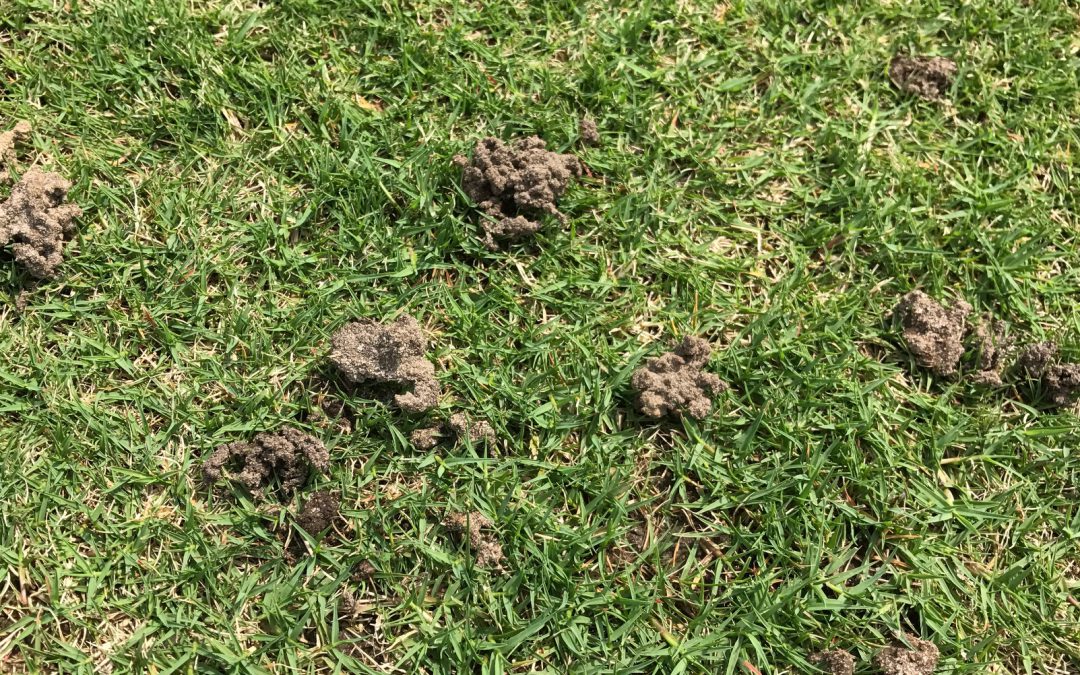
by Mary Salinas | Apr 15, 2021
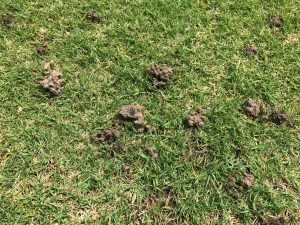
Worm mounds in bermudagrass. Photo credit Mary Salinas, UF IFAS Extension.
The April 8 program of Gardening in the Panhandle LIVE! was focused on turfgrass, quite a popular topic in the springtime as the weather warms and turf comes out of winter dormancy. Here are some of the questions asked of our University of Florida experts and the links to resources they shared.
To start with, two sites that have comprehensive information are Your Florida Lawn: http://hort.ufl.edu/yourfloridalawn/ and Gardening Solutions: https://gardeningsolutions.ifas.ufl.edu/
Turfgrass Selection
Q. What’s the answer to “I want a lawn like I had up north”? Remotely possible?
A. You can have a nice lawn, but it is going to be different in the panhandle. Don’t expect the same grass species or maintenance.
Q. What grass species is recommended for winter overseeding, and when should the grass be sown?
A. Overseeding has its problems and generally not recommended as it shades out the warm season turf as it is coming out of dormancy in the spring. Overseeding Florida Lawns for Winter Color: https://sfyl.ifas.ufl.edu/archive/hot_topics/lawn_and_garden/overseeding_winter_lawns.shtml
Q. How well do new turfgrass varieties thrive against weeds?
A. A healthy and properly maintained lawn is your best defense against weeds and other pests. Additionally, ProVista is a new cultivar of St Augustinegrass that can tolerate glyphosate so it makes it much easier to kill weeds in the lawn. ProVista is not yet widely available in the panhandle.
Q. How do I get a lawn started?
A. Preparing to Plant a Florida Lawn: https://edis.ifas.ufl.edu/lh012
Establishing a Florida Lawn: https://edis.ifas.ufl.edu/topic_lawn_establishment
Q. Can I have a native lawn? What are some recommended alternatives to a turf lawn?
A. Opinions are divided as to whether St. Augustinegrass is native. See these links for lawn Alternatives: https://gardeningsolutions.ifas.ufl.edu/lawns/turf-types/alternatives-to-turfgrass.html
https://gardeningsolutions.ifas.ufl.edu/mastergardener/webinars/mg-update-june2018/ffl-lawn-alternative-mg-update-june-2018-handout.pdf
Fertilizing & Weed Control
Q. How long should I wait before fertilizing new sod?
A. Wait 30-60 days before applying fertilizer. See: Homeowner Best Management Practices for the Home Lawn: https://edis.ifas.ufl.edu/ep236
Q. Basic fertilizer for most lawns if no other information is available.
A. 15-0-15
Q. Are weed and feed products effective? Can you use a Weed & Feed like Scott’s Bonus S this late in the year?
A. Weed and feed products are not recommended.
Weed & Feed, Not Foolproof: https://ocmga.wordpress.com/2013/03/11/weed-and-feed-not-foolproof-by-larry-williams-ufifas-extension-agent/
Weed Management Guide for Florida Lawns: https://edis.ifas.ufl.edu/ep141
Lawn Maintenance & Renovation
Q. My husband overwaters the lawn. Remind everyone about correct watering.
A. Homeowner Best Management Practices for the Home Lawn: https://edis.ifas.ufl.edu/ep236
Watering Your Florida Lawn: https://edis.ifas.ufl.edu/lh025
Sprinkler calibration: https://gardeningsolutions.ifas.ufl.edu/care/irrigation/calibrating-your-irrigation-system.html
Q. What to do about bare spots in St Augustine turf in shade?
A. Rough up the ground and put ½ to 1” compost and let the grass fill in or plant plugs. St. Augustinegrass for Florida Lawns: https://edis.ifas.ufl.edu/lh010
Q. When is the best time to overseed? I have a centipede lawn that’s 15-16 years old and I’m trying to bring it back to health.
A. Be sure to be following good practices and centipedegrass should not fail. Overseeding may not be the best option. Centipedegrass for Florida Lawns: https://edis.ifas.ufl.edu/lh009
Q. How do I repair lawn areas ruined by piled up Hurricane Sally debris?
A. Homeowner Best Management Practices for the Home Lawn: https://edis.ifas.ufl.edu/ep236
Q. How do I care for a zoysiagrass lawn?
A. Zoysiagrass for Florida Lawns: https://edis.ifas.ufl.edu/lh011
Q. Should I mulch or bag clippings?
A. Unless you have disease or weed seeds, mulch the clippings onto the turf so you can return the nutrients and water into the soil. Mowing Your Florida Lawn: https://gardeningsolutions.ifas.ufl.edu/lawns/lawn-care/mowing-your-florida-lawn.html
Pest Management
Q. When is the best time to put out a pre-emergence treatment to control and prevent weeds in your lawn (warm and cool season)?
A. Summer Annual Weed Control Timeline: https://sfyl.ifas.ufl.edu/media/sfylifasufledu/escambia/horticulture/Summer-Annual-Lawn-Weed-Control-Timeline.pdf
Winter Annual Weed Control Timeline: https://sfyl.ifas.ufl.edu/media/sfylifasufledu/escambia/horticulture/Winter-Annual-Lawn-Weed-Control-Timeline.pdf
Q. How do I manage chamberbitter in lawns?
A. Chamberbitter: https://hgic.clemson.edu/factsheet/chamberbitter/
Gallery, with the active ingredient isoxoben, has always been the best product to control chamberbitter. Another product, Gemini, adds prodiamine with isoxoben and also provides good control.
Q. How do you get dollar weed under control?
A. Control irrigation. Dollarweed loves lots of water so make sure you are not overwatering. See: https://edis.ifas.ufl.edu/ep389
Q. I used Image to help control Bahia in Centipede. Anything else that we can use?
A. Metsulfuron methyl, 3 applications every 21 days
Q. Which postemergence herbicide is safe and effective for reducing oxalis in a lawn?
A. Yellow Woodsorrel (Oxalis) Biology and Management in Turf: https://edis.ifas.ufl.edu/ep385
Q. What is the best non-poison weed killer?
A. If a product is a weed killer, whether it is organic or synthetic, it is a poison. Alternatives to Synthetic Herbicides for Container Plants & Homeowner Herbicide Guide: https://edis.ifas.ufl.edu/ep464 & https://edis.ifas.ufl.edu/ep575
Q. How do I treat lawn fungus?
A. First you need to determine which fungus, if any, is responsible. Key to Identification of Landscape Turfgrass Disease: https://edis.ifas.ufl.edu/lh064
Then turn your attention to Turfgrass Disease Management: https://edis.ifas.ufl.edu/lh040
Q. How do I diagnose and control mole crickets?
A. Look at this UF guide: https://edis.ifas.ufl.edu/in1021
This video shows how to do the soap flush to scout for mole crickets https://www.youtube.com/watch?v=sx_o4EMXsCo
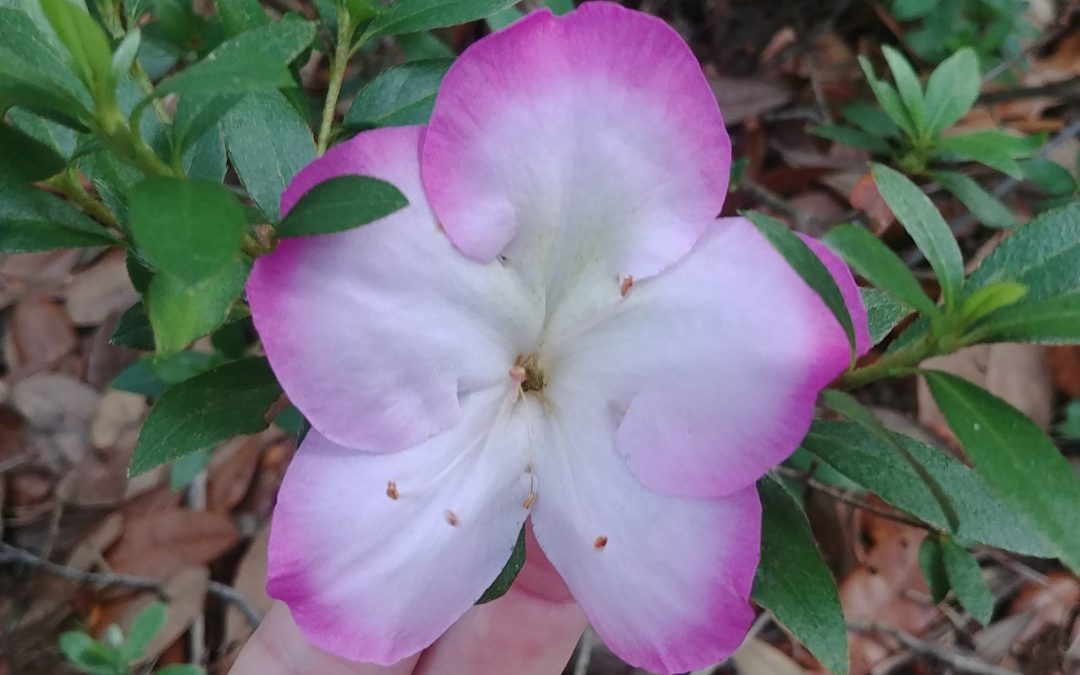
by Matt Lollar | Mar 25, 2021
Article written by Dr. Gary Knox, North Florida Research & Extension Center – Quincy, FL.
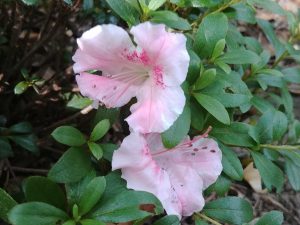
‘Gumpo Pink’ flowers are 3 inches in diameter and are pink with purplish pink dots and occasional white blotches on petals.
Background
In the times before re-blooming azaleas like Encore®, Bloom-A-Thon® and others, Satsuki azaleas were valued for late flowering that extended the azalea “bloom season”. Even with modern re-blooming azaleas, Satsuki azaleas still are appreciated as refined evergreen shrubs for the sophisticated garden or discerning plant collector.
“Satsuki” means “Fifth Month” in Japanese, corresponding to their flowering time in much of Japan. These azaleas were developed hundreds of years ago from their native Rhododendron indicum and R. eriocarpum. The Japanese selected cultivars more for their form and foliage than for flowering. These beloved plants were used in gardens as sheared boxwood-like hedges or pruned into rounded mounds that might resemble rocks or boulders in classical Japanese gardens. Their size and form also made them well adapted for training as bonsai. Most of the Satsuki azaleas in America were introduced in the 1930s by USDA.
Description
Satsuki azaleas are small evergreen shrubs that flower in April and May in north Florida, long after most older type azaleas have finished. Satsuki azaleas also are known for producing large, mostly single flowers up to 5 inches in diameter in colors of white, pink, red, reddish orange and purple. Often the flowers will include stripes, edging, blotches, spots or flecks of contrasting colors (Sometimes all on the same plant!) with more than 20 different color patterns recorded.
Satsuki azaleas have an elegant subtle charm, quite unlike the flashy, over-the-top, heavy blooming all-at-once Southern Indica azaleas like ‘Formosa’ and ‘George L. Taber’. Typically, Satsuki azaleas display a few large blooms at a time, allowing one to better appreciate their size and color patterns as contrasted against their fine-textured, dark green leaves. To make up for a less boisterous display, Satsuki azaleas flower over a longer timeframe, averaging about 8 weeks, with some flowering an amazing 14 weeks. In another contrast, most Satsuki azaleas grow smaller in size, in my experience reaching about 3 feet tall and wide in a five-year timeframe. The rounded to lance-shaped leaves of Satsuki azaleas also are demure, ranging in length from just ½ inch to no more than 2 inches.
Culture
Satsuki azaleas enjoy the same conditions as most other azaleas: light shade and moist, rich, well-drained soil. Mulch regularly to maintain organic matter and help hold moisture. Fertilize lightly and keep the roots evenly moist. Minimal to no pruning is required. Satsuki azaleas also are well adapted to container culture. Their small size and fine textured leaves make these a favorite for bonsai enthusiasts since their small leaves, branching habit and mounded form naturally make them look like miniature mature “trees”.
Sources and Cultivars
Look for Satsuki azaleas in spring at garden centers or year-round at online nurseries. There are hundreds of cultivars but some popular types to look for include:
Gumpo Pink – 3-in. diameter light pink flowers with purplish pink dots and occasional white blotches
Gumpo White – 3-in. diameter white flowers with occasional pink flakes and light green blotches
Gyokushin – 3-in. diameter flowers are predominantly white but with light to dark pink dots and blotches
Higasa – flowers are 4 to 5 inches in diameter and are purplish pink with purple blotches
Shugetsu – also called ‘Autumn Moon’, 3-in. diameter flowers are white with a broad, bright purplish-red border
Tama No Hada – flowers are 4 to 5 inches in diameter and are white to pink with deep pink stripes; usually flowers in fall as well as spring
Wakaebisu – 2.5-in. diameter flowers are “double” (hose-in-hose) and are salmon pink with deep pink dots and blotches; this also flowers in fall as well as spring
References:
Chappell, M. G.M. Weaver, B. Jernigan, and M. McCorkle. 2018. Container trial of 150 azalea (Rhododendron spp.) cultivars to assess insect tolerance and bloom characteristics in a production environment. HortScience 53(9-S): S465.
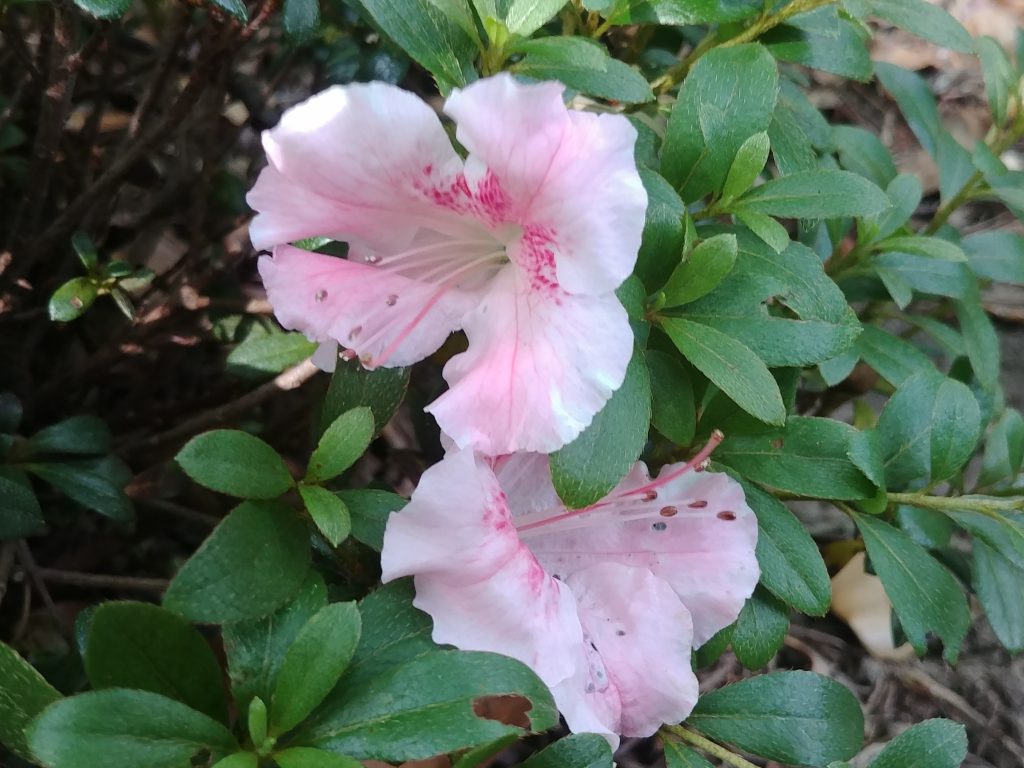
‘Gumpo Pink’ flowers are 3 inches in diameter and are pink with purplish pink dots and occasional white blotches on petals.
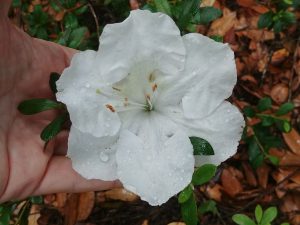
‘Gyokushin’ flowers are white with occasional pink flecks and light green blotches.
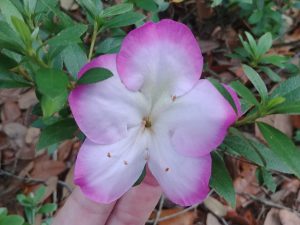
‘Shugetsu’ has 3-inch flowers that have bright purplish-red border on edges of petals.
Galle, Fred C. Azaleas. 1985. Timber Press, Portland, Oregon. 486 pp.
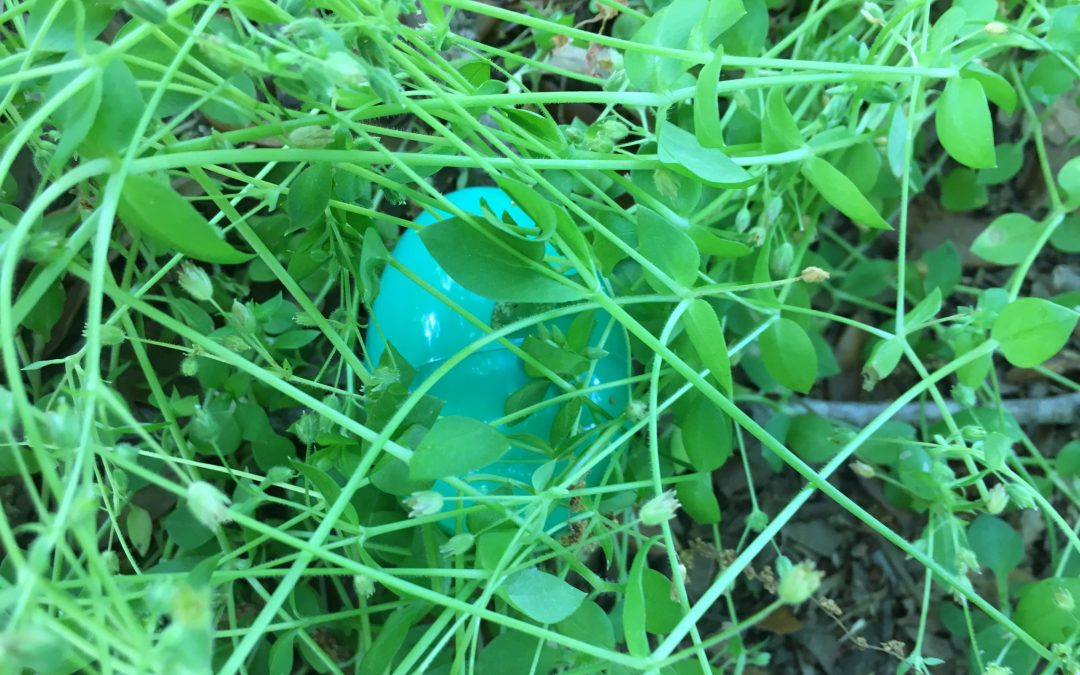
by Larry Williams | Mar 25, 2021
As a boy in a small town in Georgia we had a St. Augustinegrass lawn. My dad started the lawn before I was born. That lawn was still doing fine when I left for college at age seventeen. I don’t remember weeds in the lawn during summer months. I do fondly remember winter “weeds” in that lawn.
To see clumps of winter annuals in our yard and in neighbors’ yards was a natural part of the transition from winter to spring. They added interest to what
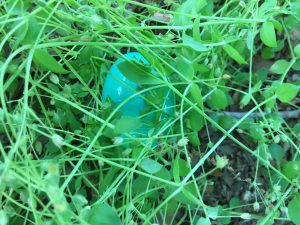
Blue Easter egg hidden in chickweed. Photo credit: Larry Williams
would have been a plain palette of green. It was expected to see henbit with its square stiff stems holding up a display of small pinkish purple flowers in late winter and early spring. A clump of henbit was a great place to hide an Easter egg, especially a pink or purple one.
Wild geranium, another common winter annual, offered another good hiding place for Easter eggs with its pink to purple flowers. Large clumps of annual chickweed would nicely hide whole eggs. Green colored eggs would blend with chickweed’s green leaves.
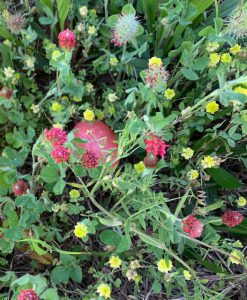
Pink Easter egg hidden in crimson clover & hop clover mix. Photo credit: Larry Williams
Crimson clover with its reddish flowers, hop clover and black medic with their bright yellow flowers were good hiding places for Easter eggs. Plus clovers add nitrogen back to our soils.
I never remember my dad using any weed killer, he rarely watered. The lawn was healthy and thick enough to be a deterrent to summer weeds. But during fall and winter as the lawn would naturally thin and go dormant, winter annual weeds would run their course.
I’ve heard that the sense of smell provides our strongest memories. I remember the first mowing of the season with the clean smell of chlorophyll in the spring air. It was refreshing. Once mowed and as the heat took its toll, by late April or mid-May, these winter annual weeds were gone. What was left was a green lawn to help cool the landscape as the weather warmed. The lawn was mowed high as St. Augustine should be, played on and typically not worried with.
Most people have winter weeds in their lawns that let us know spring is near. Perhaps we worry too much with these seasonal, temporary plants that may have wrongly been labeled as weeds. Besides, how long have we been doing battle with these weeds and they are still here. Most lawns have countless numbers of winter annual seeds awaiting the cooler temperatures and shorter days of early winter to begin yet another generation. By May they are gone.


















